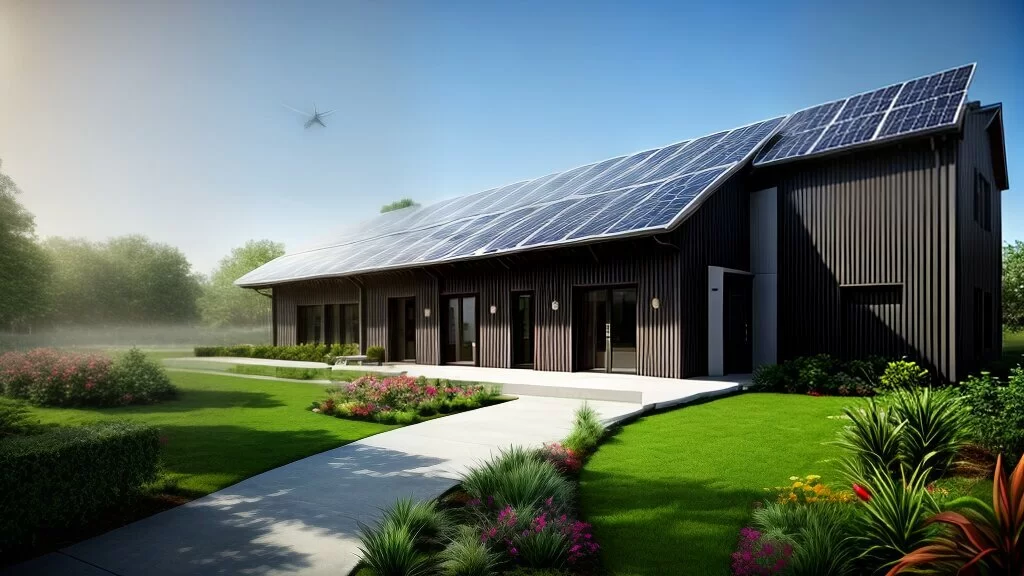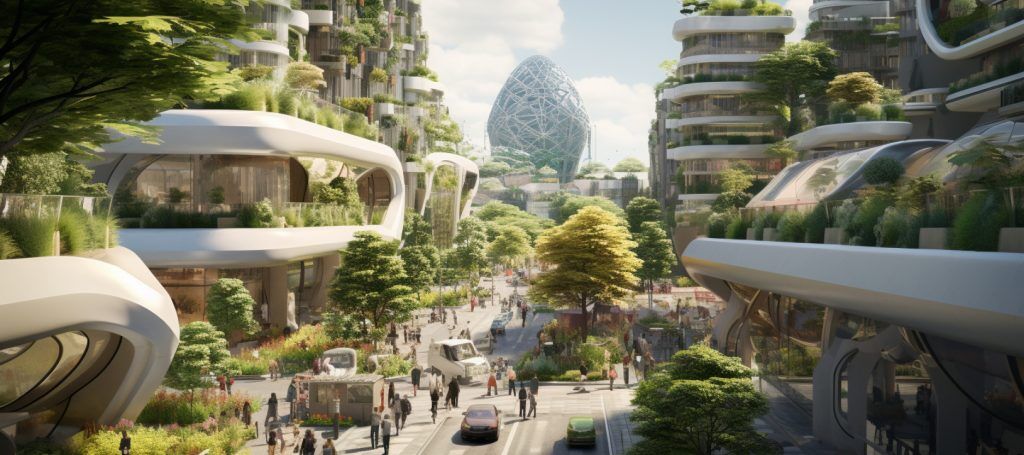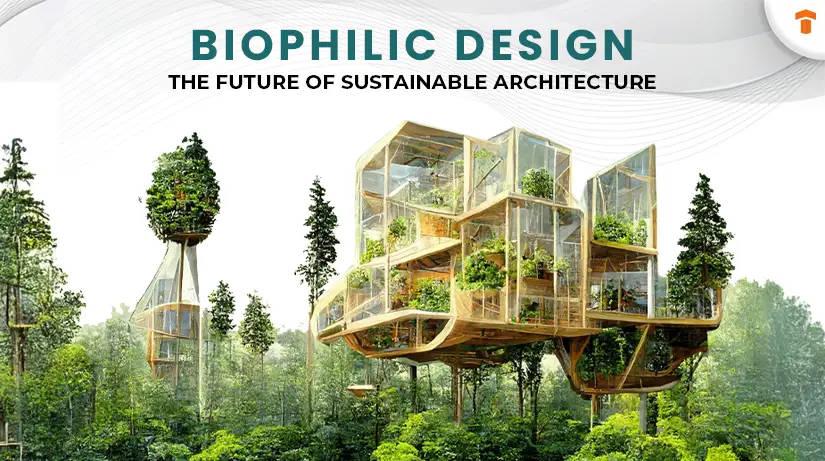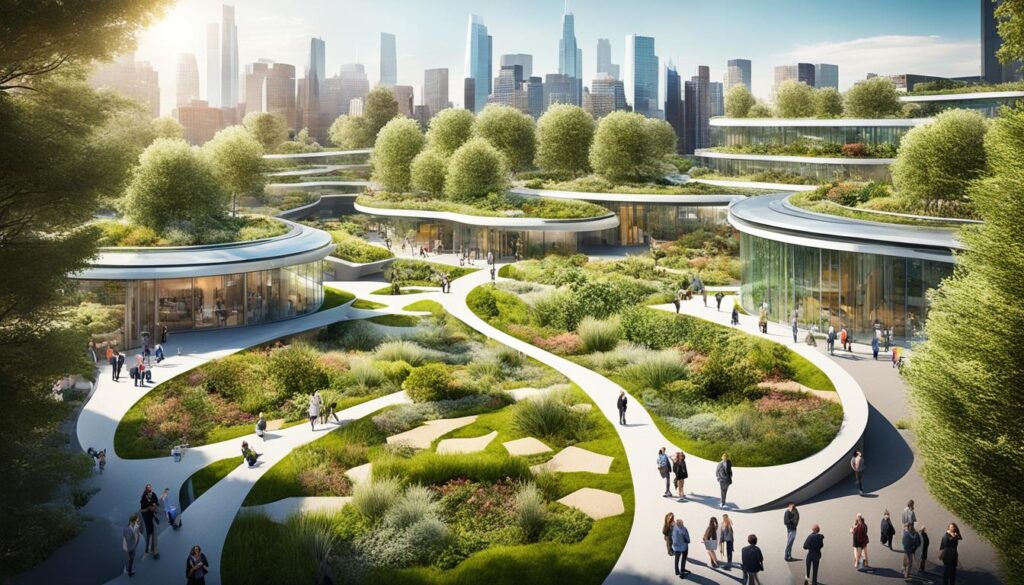Integrating Solar Power with Biophilic Design.
In an era where sustainability and well-being are of utmost importance, the integration of biophilic design and solar power presents a compelling solution for sustainable architecture and renewable energy.
This article examines the significance of biophilic design, emphasizing its environmental and economic benefits, while also highlighting its aesthetic appeal in the context of sustainable architecture and energy efficiency. It explores methods for seamlessly incorporating solar energy into biophilic structures, showcasing innovative strategies and real-world examples.
Furthermore, the article addresses the challenges associated with this integration, such as site-specific design and energy policy considerations, and envisions the future potential of this synergistic relationship. It elucidates how nature and technology can collaboratively contribute to a brighter, greener future.
Why is Biophilic Design Important?
.jpg_00.jpeg)
Biophilic design is increasingly acknowledged as a fundamental approach to architecture that cultivates a connection between individuals and the natural environment, enhancing wellness and human well-being. This design philosophy significantly contributes to sustainability and enhances human health.
By integrating natural elements and facilitating exposure to nature within built environments, biophilic design positively impacts psychological well-being and ecological balance.
The significance of this design approach extends beyond its aesthetic appeal; it also enhances user experience and fosters community resilience through nature-based solutions, promoting urban ecology and environmental sustainability.
Why Integrate Solar Power with Biophilic Design?
The integration of solar power with biophilic design presents a significant opportunity to enhance energy efficiency while promoting sustainability within architectural practices, ensuring energy independence and reducing carbon footprint.
By utilizing renewable energy sources, such as photovoltaic systems, in conjunction with natural elements, a harmonious balance is achieved between technological advancement and ecological integrity, contributing to a reduction in ecological footprint and fostering ecosystem services.
This integration not only supports efforts to mitigate climate change but also provides both aesthetic and functional benefits, thereby elevating the overall user experience in nature-inspired environments and enhancing the connection to outdoor spaces.
1. Environmental Benefits
The environmental benefits of integrating solar power with biophilic design are substantial, as this combination actively contributes to ecological sustainability and enhances biodiversity through the use of sustainable materials and habitat restoration. By reducing the ecological footprint through energy conservation strategies, such designs promote habitat restoration and the creation of ecosystems that support a diverse range of flora and fauna.
The incorporation of sustainable materials and ecological design principles fosters an environment that nurtures natural habitats while simultaneously mitigating climate change.
This synergy not only diminishes reliance on fossil fuels but also encourages the harmonious coexistence of human structures with wildlife, ultimately revitalizing local ecosystems and promoting urban greenery. By implementing green roofs, living walls, and shaded spaces, these designs attract pollinators and other beneficial species, reinforcing the interconnectedness of urban and natural environments.
A commitment to sustainable practices thus paves the way for a holistic approach to urban planning, ensuring that development enhances rather than compromises biodiversity and supports urban agriculture. This leads to the establishment of resilient ecosystems capable of withstanding environmental changes.
2. Economic Benefits
The integration of solar power with biophilic design offers substantial economic advantages, including long-term cost savings through energy production and increased property values, driven by smart grids and green technology.
Smart buildings that incorporate renewable energy sources not only attract prospective buyers but also foster community engagement and bolster local economies. As businesses and communities place greater emphasis on sustainability, the financial feasibility of such integrations presents a compelling rationale for their adoption.
When assessing the return on investment, the incorporation of solar energy can significantly reduce energy costs, resulting in favorable payback periods that appeal to both developers and homeowners, while enhancing occupant comfort and livability.
Additionally, incentives such as tax breaks and rebates enhance the attractiveness of these projects, rendering them financially accessible to a wider audience.
Case studies of notable projects demonstrate considerable improvements in market competitiveness, with some properties experiencing value increases of up to 20% following implementation.
These examples not only underscore the economic viability of such initiatives but also highlight the synergistic effect of designing with nature, thereby promoting both environmental and fiscal sustainability, integrating elements of ecological design and cultural relevance.
3. Aesthetics and Functionality
The integration of solar power with biophilic design significantly enhances both the aesthetics and functionality of architectural projects, fostering a seamless indoor-outdoor flow that strengthens the visual connection to nature through natural ventilation and daylighting. By meticulously incorporating natural elements alongside energy-efficient systems, these designs not only attract attention through their visual appeal but also fulfill practical purposes that optimize user experience and promote restorative environments, enhancing environmental psychology and user experience. This comprehensive design approach encourages engagement with outdoor spaces and facilitates interactions with nature.
For example, the implementation of green roofs not only improves insulation and reduces energy costs, but also creates a visually appealing landscape that supports biodiversity and enhances environmental aesthetics. Likewise, strategically positioned large windows and open spaces can maximize sunlight exposure, ensuring that occupants benefit from abundant natural light while minimizing reliance on artificial lighting sources, improving indoor air quality and supporting nature’s influence.
Innovative methodologies, such as the adaptive reuse of existing structures, demonstrate how functionality can harmonize with imaginative aesthetics, leading to spaces that are both environmentally responsible and visually captivating, contributing to cultural heritage preservation and architectural harmony. Ultimately, this fusion of beauty and utility enhances well-being, fostering a more sustainable relationship between occupants and their surroundings.
How to Incorporate Solar Power into Biophilic Design?
Incorporating solar power into biophilic design necessitates a strategic approach that aligns energy harvesting with natural elements to establish sustainable environments and achieve energy generation goals.
By utilizing passive solar design principles and optimizing building orientation, architects can improve natural ventilation and daylighting, leading to reduced energy consumption, enhanced indoor air quality, and improved occupant comfort.
This site-specific design methodology promotes a cohesive integration of solar panels and other renewable energy systems within the broader context of landscape architecture, ensuring effective landscape integration and site orientation.
1. Strategic Placement of Solar Panels
.jpg_01.jpeg)
The strategic placement of solar panels is essential for maximizing energy production and efficiency in biophilic design projects, ensuring optimal exposure to natural light and reducing heat gain through climate-responsive design. Appropriate building orientation, combined with a thorough understanding of the site’s geographical and climatic conditions, facilitates the effective harnessing of solar energy while enhancing the overall aesthetic framework of the design, supporting ecological impact and climate adaptation.
This meticulous approach not only improves functionality but also promotes sustainability within architectural practices.
For example, the incorporation of solar panels on rooftops or along building facades can substantially increase energy yield while integrating seamlessly with the natural environment and supporting urban design principles. Additionally, integrating greenery around these installations enhances visual appeal and fosters a harmonious relationship with nature, promoting biodiversity and ecological systems.
The use of vertical gardens or green roofs further elevates overall energy efficiency, illustrating how biophilic elements can complement solar technology and improve environmental resilience.
Moreover, strategies that account for shading, seasonal sun patterns, and local weather conditions can optimize energy output, showcasing the potential for innovative designs that address both energy requirements and ecological benefits.
2. Green Roof Design
Green roof design exemplifies the effective integration of solar power with biophilic design principles, thereby enhancing energy efficiency and promoting urban greening while supporting water management and reducing heat island effects. These living roofs significantly reduce a building’s carbon footprint while providing thermal mass that contributes to energy conservation and improved indoor climates and support ecological systems.
Through the incorporation of vegetation and sustainable materials, green roofs create habitats that support biodiversity and enhance ecological aesthetics.
Plus these environmental benefits, green roofs play a vital role in stormwater management by absorbing rainwater, which reduces runoff and alleviates pressure on urban drainage systems. This natural filtration process not only improves water quality but also enhances community resilience to flooding.
Furthermore, the integration of green roofs within landscape architecture fosters community health by creating inviting spaces for relaxation and recreation, thereby promoting mental well-being and encouraging community spaces and engagement. These green spaces serve not only aesthetic purposes but also encourage social interactions and educate residents about sustainability and nature conservation, contributing to experiential design and community engagement.
3. Solar-powered Water Features
Solar-powered water features represent an innovative approach to incorporating renewable energy into biophilic design, thereby enhancing ecological design and habitat creation, supporting water management and nature connection. These features not only provide aesthetic value and a calming atmosphere but also contribute to the establishment of restorative environments that foster biodiversity and support local flora and fauna, enhancing ecological impact and wellness.
By employing energy-efficient systems, these installations promote sustainability while enriching nature-inspired spaces, ensuring functional aesthetics and contributing to environmental design.
The integration of such water features acts as a catalyst for attracting various wildlife species that depend on aquatic habitats for survival. Furthermore, they play a significant role in water conservation efforts by utilizing closed-loop systems that minimize waste and enhance environmental aesthetics.
The soothing sounds of flowing water generated by solar power can greatly enhance the user experience, creating a serene retreat in both residential and public landscapes while promoting wellness and a connection to nature.
Additionally, the installation of these features provides valuable educational opportunities, raising awareness about renewable energy and environmental stewardship, and ultimately encouraging communities to adopt more sustainable practices and integrate biophilic design principles.
4. Natural Lighting and Ventilation
Natural lighting and ventilation are essential components of biophilic design that significantly enhance energy efficiency and contribute to a healthier indoor environment. By maximizing daylight and reducing reliance on artificial lighting, these designs can improve air quality and promote psychological well-being, in alignment with human-centered design principles. The thoughtful integration of these elements fosters a deeper connection between occupants and their surroundings.
These design strategies not only reduce energy consumption but also create spaces that are more inviting and comfortable for inhabitants. When natural light permeates a space, it brightens the environment and instills a sense of vitality among residents. Adequate ventilation is crucial to maintaining fresh indoor air, harmonizing with outdoor climate patterns, and preventing issues related to stale air and humidity.
Therefore, understanding the significance of sunlight and airflow is vital for architects and designers who aspire to create buildings that are not only aesthetically pleasing but also enhance overall well-being and sustainability.
Case Studies of Successful Integration of Solar Power and Biophilic Design
An examination of case studies that successfully integrate solar power and biophilic design offers valuable insights into innovative solutions and best practices in architecture.
These projects demonstrate how the harmonious combination of renewable energy systems and natural elements can improve sustainability, enhance user experience, and promote community health.
By analyzing these examples, it is possible to identify key strategies that contribute to the effectiveness of biophilic design implementations.
1. The Bullitt Center
The Bullitt Center in Seattle exemplifies a net-zero energy building that effectively integrates biophilic elements with solar energy, showcasing a strong commitment to sustainability and urban ecology. This innovative structure employs photovoltaic systems, green roofs, and natural ventilation to enhance energy efficiency while fostering restorative environments that support user well-being and environmental health.
The design features ample natural light and abundant greenery, effectively blurring the lines between indoor and outdoor spaces. This significantly improves occupants’ connection to nature.
Additionally, the strategic placement of large windows and extensive use of reclaimed materials not only reduce the building’s carbon footprint but also promote biodiversity within the urban landscape.
The thoughtful consideration of these design elements illustrates how modern architecture can advocate for ecological benefits while addressing the urgent challenges posed by climate change. This approach not only encourages a healthier lifestyle but also demonstrates that sustainable living and architectural innovation can indeed coexist in harmony.
2. The Edge
.jpg_10.jpeg)
The Edge, situated in Amsterdam, is distinguished for its energy-efficient design that exemplifies the principles of biophilic architecture, seamlessly integrating cutting-edge technology with natural elements. This intelligent building employs solar panels, maximizes natural light, and incorporates open spaces to enhance user experience while minimizing its environmental impact, thereby demonstrating the potential for integrating renewable energy within urban environments. The design also incorporates vertical gardens, contributing to improved indoor air quality and the overall aesthetic experience.
The structure boasts a variety of innovative systems, including an advanced climate control mechanism that maintains a comfortable indoor atmosphere while effectively utilizing solar energy. The incorporation of green spaces and natural materials is essential to its aesthetic, fostering a harmonious connection between occupants and their surroundings.
This design not only promotes the well-being of individuals but also significantly reduces dependence on conventional energy sources, illustrating how sustainable design can positively influence both physical environments and the mental health of their inhabitants.
Ultimately, The Edge serves as a benchmark for future constructions aspiring to adopt an eco-friendly approach.
3. The CIRS Building
The Centre for Interactive Research on Sustainability (CIRS) Building in Vancouver exemplifies sustainable design by effectively integrating biophilic principles with solar energy solutions to promote community engagement. This innovative facility utilizes energy-efficient systems, green roofs, and natural ventilation to establish a vibrant and restorative environment that aligns with ecological values and prioritizes user well-being.
The incorporation of large, operable windows enhances the influx of natural light and fresh air, thereby improving productivity and fostering a stronger connection to the surrounding landscape. Moreover, the strategic placement of solar panels on the roof underscores a commitment to renewable energy, illustrating how architecture can serve as a leader in sustainable practices. Such design choices highlight the importance of daylighting and passive solar design in achieving energy efficiency and reducing the building’s carbon footprint.
CIRS promotes an inclusive community by providing spaces that facilitate collaboration and learning, thereby positioning itself as a central hub for innovation in sustainability. This interactive approach not only engages users but also inspires replicable solutions for other communities seeking to improve their environmental impact and overall quality of life. The building also demonstrates the potential for urban agriculture and community gardens, further enhancing its role as a model for sustainable communities.
Challenges and Solutions for Integrating Solar Power and Biophilic Design
The integration of solar power with biophilic design encompasses several challenges that must be addressed to ensure successful implementation and enhanced sustainability. These challenges involve balancing energy efficiency with ecological impact, and ensuring that the integration of natural elements does not compromise the functionality of renewable energy systems.
These challenges include cost implications, maintenance requirements, and design considerations that influence both aesthetic and functional outcomes.
Identifying effective solutions is crucial for maximizing the benefits of this integration and attaining long-term ecological objectives. Strategies such as adaptive reuse of materials, site-specific design, and climate-responsive design can help overcome these challenges and promote a more resilient, sustainable architecture.
1. Cost and Budgeting
One of the primary challenges in integrating solar power with biophilic design is the cost and budgeting associated with renewable energy systems and sustainable materials. Financial viability is essential, as the initial investments required may dissuade stakeholders from adopting these environmentally-friendly solutions.
A comprehensive understanding of long-term savings and potential incentives can facilitate effective budget planning and promote investment in sustainable practices. By emphasizing the long-term health benefits and reduced ecological footprint, stakeholders can be more inclined to support green building initiatives.
To navigate these financial considerations effectively, stakeholders should explore various budgeting strategies, such as phasing the installation of solar systems and prioritizing key biophilic design elements that yield maximum impact.
Potential funding sources, including government grants, tax credits, and green loans, can help mitigate upfront costs. By conducting a thorough analysis of the anticipated return on investment—taking into account reduced energy expenses and increased property values—investors are likely to recognize the long-term economic advantages of integrating solar energy with nature-inspired design.
Awareness of these financial dynamics can ultimately lead to more comprehensive and sustainable development practices.
2. Maintenance and Upkeep
Maintenance and upkeep present significant challenges for the long-term success of solar systems and biophilic design implementations, as operational costs can influence overall sustainability objectives. Regular maintenance of solar panels and biophilic features is essential to ensure their efficiency and longevity. Developing a comprehensive maintenance strategy can effectively address these challenges and preserve the advantages of such integrations.
Establishing effective maintenance protocols not only extends the lifespan of these systems but also maximizes their energy output and aesthetic value. By incorporating routine inspections and cleaning schedules for solar panels, stakeholders can mitigate issues such as dirt accumulation or shading, both of which can substantially diminish output. Regular maintenance of biophilic elements, including vertical gardens and green roofs, ensures that these features continue to provide ecosystem services and contribute to the building’s overall sustainability.
For biophilic elements, it is equally important to ensure that living plants are healthy and well-maintained; this includes regular pruning, watering, and implementing pest control measures. Engaging professional services and utilizing technology for monitoring can further enhance the efficacy of these maintenance strategies, ensuring that both solar systems and natural features operate in harmony to foster sustainable environments. Effective landscape integration, including the use of native plants and habitat restoration, can also improve the resilience and ecological value of biophilic design elements.
3. Design and Construction Considerations
Design and construction considerations are critical to the successful integration of solar power and biophilic design, necessitating the resolution of architectural challenges to develop cohesive and sustainable environments.
Implementing integration strategies that emphasize sustainable design principles can facilitate the construction process while ensuring that both solar and biophilic components function synergistically within the overall design framework. Attention to building materials, site orientation, and environmental psychology can further enhance the effectiveness of these strategies, creating spaces that are both functional and aesthetically pleasing.
To achieve this synergy, architects and builders must take into account various factors, including site orientation, roof angles, and the natural lighting requirements of vegetation. Striking a balance between the visual and functional aspects of natural elements and the technical specifications of solar installations is essential for ensuring that the building not only harnesses energy efficiently but also cultivates a connection to nature. Integrating green building practices, such as passive solar design and the use of sustainable materials, further enhances the energy efficiency and ecological impact of the structure.
Furthermore, the building materials utilized in the construction process should embody biophilic principles, promoting sustainability and enhancing the psychological well-being of occupants. This includes using sustainable materials that improve indoor air quality and incorporating natural elements like indoor plants and vertical gardens to create restorative environments.
Through these meticulous considerations, the integration of renewable energy solutions with nature-inspired design can result in truly transformative spaces. Such spaces not only benefit from energy conservation but also provide health benefits and a visual connection to nature, which are key components of biophilic design.
Future Outlook and Potential of Solar Power and Biophilic Design Integration
.jpg_11.jpeg)
The future outlook for the integration of solar power and biophilic design is highly promising, as advancements in renewable energy technology, sustainable architecture, and green technology continue to progress. These advancements support the development of urban greenery, climate adaptation, and the restoration of ecological systems.
This integration presents significant potential for addressing critical environmental challenges, promoting energy independence, and enhancing human health through environments that prioritize ecological values and environmental aesthetics. By incorporating elements like natural light, landscape integration, and water management, these designs can significantly improve occupant comfort and well-being.
As awareness of these issues increases, a shift towards more comprehensive approaches that incorporate both biophilic design and renewable energy solutions is anticipated. This shift will also emphasize the importance of energy efficiency, ecological design, and environmental resilience in creating sustainable communities.
Frequently Asked Questions
1. Can solar power and biophilic design be integrated together?
Yes, it is possible to integrate solar power with biophilic design. In fact, using renewable energy sources, like solar power, is a key aspect of biophilic design, as it promotes sustainability and a connection with the natural environment.
2. What are the benefits of integrating solar power with biophilic design?
Integrating solar power with biophilic design can have numerous benefits, such as reducing reliance on non-renewable energy sources, promoting sustainable living, and creating a healthier and more visually appealing living space. It also helps in reducing the carbon footprint and enhancing the biodiversity of the area.
3. How can solar panels be incorporated into a biophilic design?
Solar panels can be incorporated into a biophilic design in various ways, such as installing them on rooftops, using them as shading elements, or even incorporating them into the design of outdoor spaces, like patios or balconies. These strategies support passive design strategies and optimize solar efficiency while enhancing the aesthetic experience of users.
4. Are there any specific design techniques for integrating solar power with biophilic design?
Yes, there are specific design techniques that can be used to integrate solar power with biophilic design, such as utilizing natural light and ventilation, incorporating natural materials, and incorporating vegetation into the design. Techniques like climate-responsive design, habitat restoration, and urban agriculture can also play a significant role.
5. Does integrating solar power with biophilic design require any additional costs?
Integrating solar power with biophilic design may require some initial investment in terms of installing solar panels or implementing sustainable design features. However, in the long run, it can lead to cost savings on energy bills, reduce the ecological footprint, and promote a more sustainable lifestyle. Additionally, it enhances the livability and environmental psychology of spaces.
6. Can integrating solar power with biophilic design be done in all types of buildings?
Yes, integrating solar power with biophilic design can be done in all types of buildings, whether it is a residential, commercial, or industrial space. The key is to incorporate sustainable design elements and utilize renewable energy sources to promote a connection with nature and reduce environmental impact. This approach can also support the development of urban ecology, community gardens, and adaptive reuse projects.

I’m Bruno, an architect with a deep passion for Biophilic Design in Urban Architecture. Throughout my career, I’ve focused on integrating natural elements into urban planning, and I created this site to share my insights and foster a deeper understanding of how biophilic principles can significantly enhance urban living. Dedicated to sustainable development, I continually explore innovative design solutions that promote both environmental and human well-being in city landscapes.














Publicar comentário